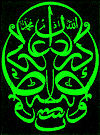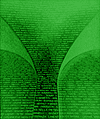Frederic
Madre
ASCIIliterature A-Z
 Arabesques:
The arabic calligraphed character in all its magnified splendor becomes
the fetishized rendering of the forbidden, that of the human reality,
body and nature, at once respectful of the holy written law and a grandiosely
perverse detour around it (see C, T.).
Arabesques:
The arabic calligraphed character in all its magnified splendor becomes
the fetishized rendering of the forbidden, that of the human reality,
body and nature, at once respectful of the holy written law and a grandiosely
perverse detour around it (see C, T.).
Blind: What we cannot see we could hear spelt out louder than most could read provided that we have a functioning real audio player plugin on our browsers (see W and come back: " 7 What we cannot speak about we must pass over in silence." then see L, Z).
Calligrammes: In this naively sweet and light volume, Guillaume Apollinaire uses the narrative text to depict graphically the objects of the narration or simply play on the emotional effects of character layout on a page,a technique that goes back as far as Rabelais. A system parallely adopted on numerous almanachs, in cyrillic or georgian script, thru out the big wide new land of the bolchevik writers (see M, Z).
Disparition (La): Beyond the "tour de force" of writing a novel without using the letter E, lies the conceptual reconsideration of the construction of literature itself that Perec constantly worked at; The tome is currently being translated by the "loustic" and francophile lit. fiend at vuk.org (see P, O).
 Electric
puppets: The blood bath of fire hatred and speed that Marinetti launched
in the futurist manifesto, blossomed in the epic Zang Tumb Tumb, a graphic
text rendition of a battle in which the petulant poet enroled as futurist
soldier, later degraded into fascist fodder (see Z).
Electric
puppets: The blood bath of fire hatred and speed that Marinetti launched
in the futurist manifesto, blossomed in the epic Zang Tumb Tumb, a graphic
text rendition of a battle in which the petulant poet enroled as futurist
soldier, later degraded into fascist fodder (see Z).
Filter: The process applied by Cosic on high-tech filmed images to transfer them into visually readable Ascii is cognate to the litterary filtering of reality, the prism of utopic poetry, the sublimation of fiction by fiction itself producing terminal theory (see G).
Godard: in the beginning there was silence, the text was displayed between the scenes, cut off, then there was "M" and the damning character was on the murderer marking him as doomed, then fast forward thru technicolor, then the letters invaded the screen brutally obstructing meaning as well as dialectically forming it, the letters were "JLG", mark of the cineast who would eventually make a video history of cinema into a book (see K).
History: A small dark room in which 12 women, each seated at a terminal, talking about their women's life, punch rectangular holes into cards according to 80 character wide formatted sheets handwritten by men programmers; pile of resulting cards inserted into the reading-encoding machine; lines of red blinking diodes on the side of the IBM 360 computer; 3 meter long printout of a curvaceous ascii'ed babe in a bikini over green and white lined paper, laid on the floor of the printing room (see J).
 I:
The slimest character used in Ascii art. A tenuous presence, an upright
visible dash of darkness in light, a simple ghostly flame at dusk. Still
far from Rimbaud's visions of "spat blood" (see N, V.).
I:
The slimest character used in Ascii art. A tenuous presence, an upright
visible dash of darkness in light, a simple ghostly flame at dusk. Still
far from Rimbaud's visions of "spat blood" (see N, V.).
Java: is literature compiled or interpreted ? Can the aging Gartner Group descriptive model of client-server illuminate ascii creativity ? does the poetic nature of a cadavre exquis reside in the fold, the folding, the paper or the movement of the hand ? is Cosic's Asciimator applet the ultimate development of server-side surrealism ? (see B, F, H, T, U, W).
Keiko: Bearded old men love young japanese girls, in print. Keiko Suzuki is the publisher of potential books, her open personality allows different and other readings of her personal emails (see H, U).
Lettrisme: This movement formed literally during a very parisian heckling interruption of a dad(a) oeuvre by Tristan Tzara. Isidore Isou, a romanian living in France, stormed the stage and stole the show with his human digito-analogue rants (itself based on a long tradition of games such as the early rhetoricians would play) and gained a few dedicated followers on the spot. Later, Guy Debord hijacked the movement, made it and Internationale and then dropped the lettrist monicker not before having proceeded to mass exclusions first (see A, B, C).
Mallarmé: with the publication of "un coup de dés jamais n'abolira le hasard" in 1897, Stephane Mallarmé, early experimentator of the dialogue between the black and the space takes hold of the page as new frontier of literary discovery. Hundred years later, Cosic cites him as the Godfather of Ascii art (see I, T).
Noir: a conceptual state of mind, as with any genre, defines and circonstricts an autonomous area of creativity within existing and widely accepted parameters of normalized culture, subverting its icons into dangerous agit-prop logos. As Noir literature emerged as the individualistic voice of dissent in the post war counter revolutionary era of industrialization so does ascii art mark the time of political radicalist aversion to the net's slick click-me shut up and pay consumerisation (see G, U, X).
 Oulipo:
Ou(vroir de la)Li(ttérature)Po(tentielle) or workshop for potential litterature,
created by Raymond Queneau this club of literary mathematicians and creative
constraint hobbyists included Georges Perec, Marcel Duchamp, Italo Calvino.
An Oulipien writer is described as "a rat that itself constructs the maze
from which it will wish to get out" (see D, P and whoever had the idea
of this A-Z).
Oulipo:
Ou(vroir de la)Li(ttérature)Po(tentielle) or workshop for potential litterature,
created by Raymond Queneau this club of literary mathematicians and creative
constraint hobbyists included Georges Perec, Marcel Duchamp, Italo Calvino.
An Oulipien writer is described as "a rat that itself constructs the maze
from which it will wish to get out" (see D, P and whoever had the idea
of this A-Z).
Pataphysics: The science of imaginary solutions, brainchild and life of Alfred Jarry reknowed for his absurdist theatre around the character of Ubu, became a major influence on Georges Perec and (see Q) and friend of Alphonse Allais the master of wacky nonsense whose genius can be attributed as much to the profuse absorption of absinthe as to being paid by the word for a daily paper (see B, C, D, O).
Queneau: A reconfigurable set of sentences, on separately printed paper strips, that the reader can choose to assemble at will forming an improbable number of would be individual texts form "100 000 000 000 000 de poêmes" by Raymond Queneau. Should be adapted to ascii at an indeterminate date in the future by our favorite no land's man and liberator (see D, O, S).
Riverrun: begin and end of Joyce's Finnegans Wake, as an infinite loop, of life itself in its embrace of all idioms of endless humanity, the irish babel of flowing joy and recursive pain, the 69 of mother tongues (see Cosic's ascii "deep throat").
Soup: look into the dish, make a wish, poke a spoon at it, eat it. The soft nourishing alphabet of happy children (see L, T).
T[o]ypo[lo]g(y)/(raphy): the complex life of signs and signmakers, their consenting slaves, their wives mistresses and family. Form and function, anyone ? (see A, C, F, M, X).
Utopia: Death to Theory, long live the Conceptual which empowers one and each with the will to fictionalize therefore mythify an emblematic reality. Lawrence Weiner is a bearded old man (see K).
Voyelles: in an attempt to idolize each vowel (except the difficult Y) by attaching to them a simple few vaguely romantic verses Arthur Rimbaud managed to both pave the way for onomatopeic poetry and alienate the rest of his work to hordes of bored francophone school-goers (see L, S).
Wittgenstein: Mathematics as fictional reconfiguration tool of existence, Geometry as tactical representation of thought. "anyone who understands me eventually recognizes [my propositions] as nonsensical, when he has used them--as steps--to climb up beyond them. (He must, so to speak, throw away the ladder after he has climbed up it.)". (see B and exit loop).
X: see X. (Documenta number ten tried to cross itself out right from the beginning, as its logo of a branded red X on tender burnt D; ten times over X, Cosic resurrects its obliterated web site from annihilation). X, done.
Y: France 10 points. At the game of Scrabble the value of a letter is inversely proportional to its absorption rate in a particular language (see D).
Zaum: A transrational language devised by russian poet cum designer Velemir Khlebnikov with Iliaz Dzanevitch to project the phonic signifier's power as significant in itself. A materialistic approach to poetry conceptualized to lift it out of its academic pre-Revolutionary conservative rot. Khlebnikov was a founding member of LEF along with Maiakowski (see B).